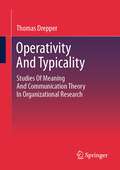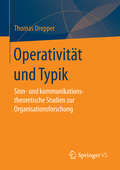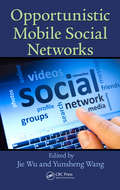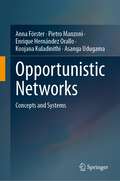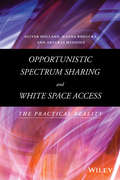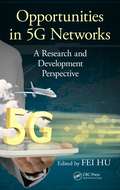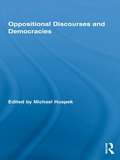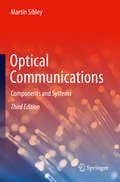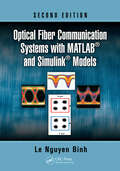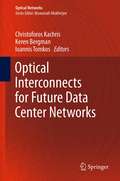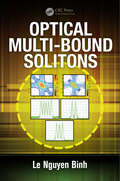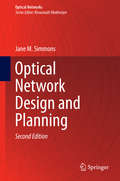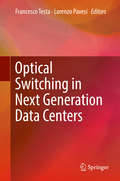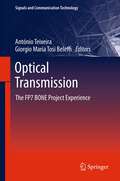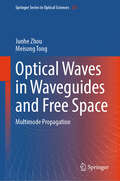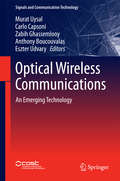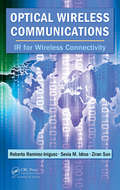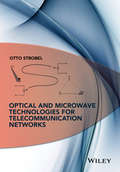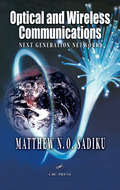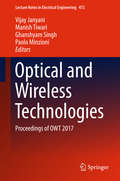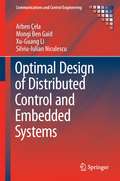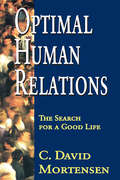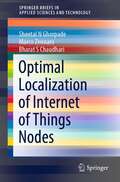- Table View
- List View
Operativity And Typicality: Studies Of Meaning And Communication Theory In Organizational Research
by Thomas DrepperThe present text discusses sense-theoretical foundations of recent organizational research and makes them visible by analyzing epistemological terms of current discourses in organizational science (cognition, institution, practice, culture, communication, semantics). In a further step, communication is discussed as an operative guiding concept for understanding organizational reproduction and networking and applied to various organizational phenomena (managementization, standardization, circulation of ideas, translation, design). This book thus sees itself both as a contribution to theory development in organizational research and as a contribution to the research field of "(world) society and organization." Overall, the individual studies in this text discuss and explore the relevance of an epistemological, social and societal foundation of organization theory on the basis of an operational theory of meaning.This book is a translation of an original German edition. The translation was done with the help of artificial intelligence (machine translation by the service DeepL.com). A subsequent human revision was done primarily in terms of content, so that the book will read stylistically differently from a conventional translation.
Operativität und Typik
by Thomas DrepperDer vorliegende Text diskutiert sinntheoretische Grundlagen der neueren Organisationsforschung und macht diese durch die Analyse erkenntnisleitender Begriffe aktueller organisationswissenschaftlicher Diskurse (Kognition, Institution, Praxis, Kultur, Kommunikation, Semantik) sichtbar. In einem weiteren Schritt wird Kommunikation als operativer Leitbegriff zum Verständnis organisationaler Reproduktion und Vernetzung diskutiert und auf verschiedene Organisationsphänomene (Managementisierung, Standardisierung, Ideenzirkulation, Übersetzung, Design) angewendet. Dieses Buch versteht sich damit sowohl als ein Beitrag zur Theorieentwicklung in der Organisationsforschung als auch als ein Beitrag im Forschungsfeld „(Welt-)Gesellschaft und Organisation“. Insgesamt wird in den Einzelstudien dieses Textes die Relevanz einer erkenntnis-, sozial- und gesellschaftstheoretischen Fundierung der Organisationstheorie auf Basis einer operativen Sinntheorie diskutiert und ausgelotet.
Opportunistic Mobile Social Networks
by Jie Wu Yunsheng WangThe widespread availability of mobile devices along with recent advancements in networking capabilities make opportunistic mobile social networks (MSNs) one of the most promising technologies for next-generation mobile applications. Opportunistic Mobile Social Networks supplies a new perspective of these networks that can help you enhance spontaneo
Opportunistic Networks: Concepts and Systems
by Anna Förster Pietro Manzoni Enrique Hernández Orallo Koojana Kuladinithi Asanga UdugamaThis textbook provides an exhaustive exploration of Opportunistic Networks (OppNets). Divided into three parts, it starts with the foundational principles and metrics of OppNets, detailing their mobility and data dissemination. Significant focus is given to the security challenges faced by OppNets, including strategies to counter various attacks. The second part evaluates OppNets, introducing methods and metrics for assessment, theoretical and simulation models, and tools such as OMNeT++, The ONE and ns-3.This textbook also offers comparative analyses and discussions on benchmarking. The third part delves into the implementation of OppNets, discussing technologies from Mobile Ad Hoc Networks to satellite communication and their integration with cellular technologies like 4G, 5G and 6G. Detailed insight into device characterization reveals the potential and limitations of devices within OppNets. Practical applications of OppNets in scenarios such as disaster management, remotecommunication, IoT challenges, smart cities and satellite networks are presented as well. Through detailed discussions and case studies, readers gain a comprehensive understanding of the structure, operation and practical implications of OppNets. It equips readers with knowledge to appreciate the vast potential of OppNets in various applications and settings.This textbook targets advanced-level students and postdocs in computer science and electrical engineering as well as researchers, who are starting new in the area and need a comprehensive view of opportunistic networks. Practitioners who are interested in applying the concepts of opportunistic networks in their products and services, and would like to have a jump start into the development and applications of opportunistic networks will also want to purchase this book as a reference.
Opportunistic Spectrum Sharing and White Space Access
by Arturas Medeisis Oliver Holland Hanna BoguckaDetails the paradigms of opportunistic spectrum sharing and white space access as effective means to satisfy increasing demand for high-speed wireless communication and for novel wireless communication applications This book addresses opportunistic spectrum sharing and white space access, being particularly mindful of practical considerations and solutions. In Part I, spectrum sharing implementation issues are considered in terms of hardware platforms and software architectures for realization of flexible and spectrally agile transceivers. Part II addresses practical mechanisms supporting spectrum sharing, including spectrum sensing for opportunistic spectrum access, machine learning and decision making capabilities, aggregation of spectrum opportunities, and spectrally-agile radio waveforms. Part III presents the ongoing work on policy and regulation for efficient and reliable spectrum sharing, including major recent steps forward in TV White Space (TVWS) regulation and associated geolocation database approaches, policy management aspects, and novel licensing schemes supporting spectrum sharing. In Part IV, business and economic aspects of spectrum sharing are considered, including spectrum value modeling, discussion of issues around disruptive innovation that are pertinent to opportunistic spectrum sharing and white space access, and business benefits assessment of the novel spectrum sharing regulatory proposal Licensed Shared Access. Part V discusses deployments of opportunistic spectrum sharing and white space access solutions in practice, including work on TVWS system implementations, standardization activities, and development and testing of systems according to the standards. Discusses aspects of pioneering standards such as the IEEE 802.22 "Wi-Far" standard, the IEEE 802.11af "White-Fi" standard, the IEEE Dynamic Spectrum Access Networks Standards Committee standards, and the ETSI Reconfiguration Radio Systems standards Investigates regulatory and regulatory-linked solutions assisting opportunistic spectrum sharing and white space access, including geo-location database approaches and licensing enhancements Covers the pricing and value of spectrum, the economic effects and potentials of such technologies, and provides detailed business assessments of some particularly innovative regulatory proposals The flexible and efficient use of radio frequencies is necessary to cater for the increasing data traffic demand worldwide. This book addresses this necessity through its extensive coverage of opportunistic spectrum sharing and white space access solutions. Opportunistic Spectrum Sharing and White Space Access: The Practical Reality is a great resource for telecommunication engineers, researchers, and students.
Opportunities in 5G Networks: A Research and Development Perspective
by Fei HuOpportunities in 5G Networks: A Research and Development Perspective uniquely focuses on the R&D technical design of 5th-generation (5G) networks. It is written and edited by researchers and engineers who are world-renown experts in the design of 5G networks. The book consists of four sections: The first section explains what 5G is, what its re
Oppositional Discourses and Democracies (Routledge Studies in Social and Political Thought)
by Michael HuspekWhen citizens take to the streets or pack assembly halls or share their ideas through the minority press, they often give voice to truths and logic that have otherwise been given little or no airing through the available institutional channels offered by democratic states. Such discourses offer new rhetorical strategies for the expression of citizen desires, needs and emotions that otherwise go unrecognized and unaddressed. They also offer impetus for new forms of deliberation and informed action that can result in real political change. This collection explores the tensions between democratic states and the dynamics of citizen voice. In so doing, the collection addresses such questions as: What role do oppositional discourses play in increased democratization? Can oppositional discourses be sustained over time? How do states resist pressures to democratize? This volume will be of interest to students and scholars in Politics, Sociology, and Communication.
Optical Code Division Multiple Access
by Ken-Ichi KitayamaA comprehensive guide to optical fiber communications, from the basic principles to the latest developments in OCDMA for Next-Generation Fiber-to-the-Home (FTTH) systems. Part I starts off with the fundamentals of light propagation in optical fibers, including multiple access protocols, and their enabling techniques. Part II is dedicated to the practical perspectives of Next-Generation Fiber-to-the-Home (FTTH) technology. It covers the key building blocks of OCDMA, devices such as optical encoders and decoders, signal impairments due to noise, and data confidentiality, a unique property of OCDMA. This is followed by hybrid system architectures with TDM and WDM and practical aspects such as system cost, energy efficiency and long-reach PONs. Featuring the latest research, with cutting-edge coverage of system design, optical implementations, and experimental demonstrations in test beds, this text is ideal for students, researchers and practitioners in the industry seeking to obtain an up-to-date understanding of optical communication networks.
Optical Communications: Components and Systems
by Martin SibleyThe long-awaited third edition of this classic textbook provides a genuinely accessible introduction to the principles and technology of optical communication systems. It takes the reader from the fundamentals of light propagation in optical fibre, through materials and fabrication methods, light sources and modulation, to photodiodes and receiver design, and concludes with a chapter looking at system level integration.Updated throughout, major changes for this third edition include:- coverage of advanced semiconductor laser diode structures (VCSELs and DFBs)- an extended section on fibre amplifiers and lasers- updated discussion of avalanche photodiode structures- expanded coverage of transimpedance and optical preamplifiers- new sections on free-space optical links, VLC, ethernet links, coherent detection and terabit systemsEnhanced with worked examples and end-of-chapter problem sets, the book is aimed at advanced undergraduate and graduate students in electronic engineering, optical science and applied physics, and is ideally suited for adoption as a course text.
Optical Fiber Communication Systems with MATLAB® and Simulink® Models (Optics and Photonics)
by Le Nguyen BinhCarefully structured to instill practical knowledge of fundamental issues, Optical Fiber Communication Systems with MATLAB and Simulink Models describes the modeling of optically amplified fiber communications systems using MATLAB and Simulink. This lecture-based book focuses on concepts and interpretation, mathematical procedures, and engineering
Optical Interconnects for Future Data Center Networks
by Christoforos Kachris Ioannis Tomkos Keren BergmanOptical Interconnects in Future Data Center Networks covers optical networks and how they can be used to provide high bandwidth, energy efficient interconnects for future data centers with increased communication bandwidth requirements. This contributed volume presents an integrated view of the future requirements of the data centers and serves as a reference work for some of the most advanced solutions that have been proposed by major universities and companies. Collecting the most recent and innovative optical interconnects for data center networks that have been presented in the research community by universities and industries, this book is a valuable reference to researchers, students, professors and engineers interested in the domain of high performance interconnects and data center networks. Additionally, Optical Interconnects in Future Data Center Networks provides invaluable insights into the benefits and advantages of optical interconnects and how they can be a promising alternative for future data center networks.
Optical Multi-Bound Solitons (Optics and Photonics)
by Le Nguyen BinhOptical Multi-Bound Solitons describes the generation and transmission of multi-bound solitons with the potential to form the basis of the temporal coding of optical data packets for next-generation nonlinear optical systems. The book deals with nonlinear systems in terms of their fundamental principles, associated phenomena, and signal processing applications in contemporary optical systems for communications and laser systems, with a touch of mathematical representation of nonlinear equations to offer insight into the nonlinear dynamics at different phases. The text not only delineates the strong background physics of such systems but also: Discusses the phase evolution of the optical carriers under the soliton envelopes for the generation of multi-bound solitons Explains the generation of multi-bound solitons through optical fibers Examines new types of multi-bound solitons in passive and active optical resonators Conducts bi-spectral analyses of multi-bound solitons to identify the phase and power amplitude distribution property of bound solitons Presents experimental techniques for the effective generation of bound solitons Optical Multi-Bound Solitons provides extensive coverage of multi-bound solitons from the dynamics of their formation to their transmission over guided optical media. Appendices are included to supplement a number of essential definitions, mathematical representations, and derivations, making this book an ideal theoretical reference text as well as a practical professional guidebook.
Optical Network Design and Planning
by Jane M. SimmonsThis book takes a pragmatic approach to deploying state-of-the-art optical networking equipment in metro-core and backbone networks The book is oriented towards practical implementation of optical network design. Algorithms and methodologies related to routing, regeneration, wavelength assignment, sub rate-traffic grooming and protection are presented, with an emphasis on optical-bypass-enabled (or all-optical) networks. The author has emphasized the economics of optical networking, with a full chapter of economic studies that offer guidelines as to when and how optical-bypass technology should be deployed This new edition contains: new chapter on dynamic optical networking and a new chapter on flexible/elastic optical networks. Expanded coverage of new physical-layer technology (e. g. , coherent detection) and its impact on network design and enhanced coverage of ROADM architectures and properties, including colorless, directionless, contentionless and gridless. Covers 'hot' topics, such as Software Defined Networking and energy efficiency, algorithmic advancements and techniques, especially in the area of impairment-aware routing and wavelength assignment. Provides more illustrative examples of concepts are provided, using three reference networks (the topology files for the networks are provided on a web site, for further studies by the reader). Also exercises have been added at the end of the chapters to enhance the book's utility as a course textbook.
Optical Switching in Next Generation Data Centers
by Lorenzo Pavesi Francesco TestaThis book introduces the reader to the optical switching technology for its application to data centers. In addition, it takes a picture of the status of the technology and system architecture evolution and of the research in the area of optical switching in data center. The book is organized in four parts: the first part is focused on the system aspects of optical switching in intra-data center networking, the second part is dedicated to describing the recently demonstrated optical switching networks, the third part deals with the latest technologies developed to enable optical switching and, finally, the fourth part of the book outlines the future prospects and trends.
Optical Transmission
by António Teixeira giorgio maria tosi beleffiOptical Transmission represents a wide set of visions of researchers who are active in the actual research scene in Europe. An aggregate of highlights of research in transmission with a state of the art presented by the researchers who are driving it are presented. The trends on research are in this book presented by one of the widest networks of excellence put together in Europe in the field of optical networking (more than 40 Research institutions were involved). The readers will find a specialized readout of the current trends and status of transmission ranging from simulation to ultimate experimental results, from modulations to devices. A highlight of Optical Transmission is the introduction in a technical book a chapter on techno-economics, which drives the vision and field a little further. General reading could be made however is more suited for graduated users. The most important features of Optical Transmission are: wide vision on transmission related issues, state of the art and related trends and techniques; techno-economics of the field.
Optical Waveguides Analysis and Design
by Amal BanerjeeThis book offers readers a comprehensive, detailed analysis and treatment of optical waveguides (fiber, slab), an essential component of ultra-high bandwidth long, medium and short-haul telecommunication. The author describes an analysis scheme for optical waveguides that combines both geometric|ray optics and Maxwell’s equations-based classical electrodynamics. This unique approach enables readers to develop an intuitive understanding of this topic, starting with macro properties, e.g., V parameter of an optical fiber, and progressively refining the analysis to individual modes of propagation through an optical waveguide. An exhaustive set of diagrams highlight the key features of an optical waveguide property, such as acceptance angle, meridional and skew rays in an optical fiber, or signal attenuation and dispersion in an optical waveguide. The author also provides a set of ready-to-use, ANSI C executables (for both Linux and Windows) that enable the reader to e.g, determine the allowed propagation modes (even, odd TE|TM) of a graded, step index optical fiber and a slab waveguide.Offers readers a single-source reference to the analysis and design of optical waveguides;Begins with macro-level analysis of the properties of optical waveguides and dives deeply into details in a step-by-step manner, enabling readers to develop an intuitive understanding;Includes C language executables, along with optical waveguide analysis and design examples to demonstrate their use in context.
Optical Waves in Waveguides and Free Space: Multimode Propagation (Springer Series in Optical Sciences #251)
by Junhe Zhou Meisong TongThis book provides a thorough review of multi-mode propagation inside optical waveguides and free space, which is receiving particular attention for its promising applications in communications and sensing. At the heart of the book is the matter of how modes couple and interfere due to engineered or random index fluctuations, forming functional devices. The chapters cover topics such as multi-mode interference, coupled mode theory, and mode generation. Readers discover how a universal coupled mode theory can describe mode propagation, enabling stochastic analysis and avoiding time-consuming simulations. The book also delves into mode division multiplexing systems and digital signal processing (DSP) algorithm-enabled multiple-input multiple-output (MIMO) transmission in multi-mode systems. Researchers in the field of optical communications and for physicists and engineers will find this book to be invaluable. It offers a comprehensive review of multi-mode transmission systems' basic physics and applications, making it essential for anyone interested in advancing their understanding of this rapidly expanding field.
Optical Wireless Communications
by Murat Uysal Carlo Capsoni Zabih Ghassemlooy Anthony Boucouvalas Eszter UdvaryThis book focuses on optical wireless communications (OWC), an emerging technology with huge potential for the provision of pervasive and reliable next-generation communications networks. It shows how the development of novel and efficient wireless technologies can contribute to a range of transmission links essential for the heterogeneous networks of the future to support various communications services and traffic patterns with ever-increasing demands for higher data-transfer rates. The book starts with a chapter reviewing the OWC field, which explains different sub-technologies (visible-light, ultraviolet (UV) and infrared (IR) communications) and introduces the spectrum of application areas (indoor, vehicular, terrestrial, underwater, intersatellite, deep space, etc. ). This provides readers with the necessary background information to understand the specialist material in the main body of the book, which is in four parts. The first of these deals with propagation modelling and channel characterization of OWC channels at different spectral bands and with different applications. The second starts by providing a unified information-theoretic treatment of OWC and then discusses advanced physical-layer methodologies (including, but not limited to: advanced coding, modulation diversity, cooperation and multi-carrier techniques) and the ultimate limitations imposed by practical constraints. On top of the physical layer come the upper-layer protocols and cross-layer designs that are the subject of the third part of the book. The last part of the book features a chapter-by-chapter assessment of selected OWC applications. Optical Wireless Communications is a valuable reference guide for academic researchers and practitioners concerned with the future development of the world's communication networks. It succinctly but comprehensively presents the latest advances in the field.
Optical Wireless Communications: IR for Wireless Connectivity
by Roberto Ramirez-Iniguez Sevia M. Idrus Ziran SunOver the last three decades, interest in Infrared (IR) technology as a medium to convey information has grown considerably. This is reflected by the increasing number of devices such as laptops, PDAs, and mobile phones that incorporate optical wireless transceivers and also by the increasing number of optical wireless links available for indoor and
Optical and Microwave Technologies for Telecommunication Networks
by Otto StrobelThis is a self-contained book on the foundations and applications of optical and microwave technologies to telecommunication networks application, with an emphasis on access, local, road, cars, trains, vessels and airplanes, indoor and in-car data transmission as well as for long-distance fiber-systems and application in outer space and automation technology. The book provides a systematic discussion of physics/optics, electromagnetic wave theory, optical fibre technology, and the potential and limitations of optical and microwave transmission.
Optical and Wireless Communications: Next Generation Networks (Electrical Engineering and Applied Signal Processing Series)
by Matthew N.O. Sadiku<p>Optical and wireless technologies are being introduced into the global communications infrastructure at an astonishing pace. Both are revolutionizing the industry and will undoubtedly dominate its future, yet in the crowded curricula in most electrical engineering programs, there is no room in typical data communications courses for proper coverage of these "next generation" technologies.Optical and Wireless Communications: Next Generation Networks covers both types of networks in a unique presentation designed for a one-semester course for senior undergraduate or graduate engineering students. <p>Part I: Optical Networks covers optical fibers, transmitters, receivers, multiplexers, amplifiers, and specific networks, including FDDI, SONET, fiber channel, and wavelength-routed networks. Part II:Wireless Networks examines fundamental concepts and specific wireless networks, such as LAN, ATM, wireless local loop, and wireless PBXs. This section also explores cellular technologies and satellite communications. <p>Eventually, next generation networks will be as ubiquitous as traditional telephone networks, and today's engineering students must be prepared to meet the challenges of optical and wireless systems development and deployment. Filled with illustrations, examples, and end-of-chapter problems, Optical and Wireless Communications: Next Generation Networks provides a brief but comprehensive introduction to these technologies that will help future engineers build the foundation they need for success.</p>
Optical and Wireless Technologies: Proceedings Of Owt 2017 (Lecture Notes In Electrical Engineering #472)
by Ghanshyam Singh Vijay Janyani Manish Tiwari Paolo MinzioniThis book presents selected papers from 1st International Conference on Optical and Wireless Technologies, providing insights into the analytical, experimental, and developmental aspects of systems, techniques, and devices in these spheres. It explores the combined use of various optical and wireless technologies in next-generation networking applications, and discusses the latest developments in applications such as photonics, high-speed communication systems and networks, visible light communication, nanophotonics, and wireless and multiple-input-multiple-output (MIMO) systems. The book will serve as a valuable reference resource for academics and researchers across the globe.
Optimal Design of Distributed Control and Embedded Systems
by Silviu-Iulian Niculescu Xu-Guang Li Arben Çela Mongi Ben GaidOptimal Design of Distributed Control and Embedded Systems focuses on the design of special control and scheduling algorithms based on system structural properties as well as on analysis of the influence of induced time-delay on systems performances. It treats the optimal design of distributed and embedded control systems (DCESs) with respect to communication and calculation-resource constraints, quantization aspects, and potential time-delays induced by the associated communication and calculation model. Particular emphasis is put on optimal control signal scheduling based on the system state. In order to render this complex optimization problem feasible in real time, a time decomposition is based on periodicity induced by the static scheduling is operated. The authors present a co-design approach which subsumes the synthesis of the optimal control laws and the generation of an optimal schedule of control signals on real-time networks as well as the execution of control tasks on a single processor. The authors also operate a control structure modification or a control switching based on a thorough analysis of the influence of the induced time-delay system influence on stability and system performance in order to optimize DCES performance in case of calculation and communication resource limitations. Although the richness and variety of classes of DCES preclude a completely comprehensive treatment or a single "best" method of approaching them all, this co-design approach has the best chance of rendering this problem feasible and finding the optimal or some sub-optimal solution. The text is rounded out with references to such applications as car suspension and unmanned vehicles. Optimal Design of Distributed Control and Embedded Systems will be of most interest to academic researchers working on the mathematical theory of DCES but the wide range of environments in which they are used also promotes the relevance of the text for control practitioners working in the avionics, automotive, energy-production, space exploration and many other industries.
Optimal Human Relations: The Search for a Good Life
by C. David MortensenThis volume deals with the human desire to live the good life, defined as seeking that which "is good, optimal, or ultimately desirable." While there may be different ways of achieving this goal, the pathways are similar in some ways. In exploring the ways in which these paths cross, Mortensen asserts that an ability to sustain optimal human relations--that is, healthy communication, interpersonal compatibility, and prosocial influence--is a standard against which the good life can be measured. Optimal Human Relations explores the favorable conditions for human beings to live the best possible way of life imaginable; it both argues the case for and documents recent advances in the study of social influences on everyday life. Social influences help to develop an expansive sense of intrinsic motivation in daily encounters with others. While optimal relations are not easily achieved or maintained, it is through healthy relationships that one may pursue pleasure and happiness--even meaning, importance, and significance with valued companions. The cultivation of physical, emotional, intellectual, and spiritual health through these relations generates an enhanced sense of well-being, growth, and maturity. Mature individuals are more likely to maintain optimal relations by counting daily blessings more than lamenting routine burdens. This inspirational conception of "the good life" invites productive inquiry into the conditions responsible for the pursuit of optimal conditions, fulfilled expectations, and a rich, vital, way of life. It is through this lens that Mortensen measures the good life, pointing to these aspects of human communication as a litmus test of the relative importance of individualistic and collective orientations. Along the way, the reader discovers who and what we are in relation to the quality of the world in which we reside alongside those who journey with us.
Optimal Localization of Internet of Things Nodes (SpringerBriefs in Applied Sciences and Technology)
by Marco Zennaro Sheetal N Ghorpade Bharat S ChaudhariThis book is a practical resource for designing Internet of Things (IoT) networks and implementing IoT applications from the localization perspective. With the emergence of IoT, machine to machine communication, Industrial IoT, and other societal applications, many applications require knowledge of the exact location of mobile IoT nodes in real-time. As the IoT nodes have computational and energy limitations, it is a crucial research challenge to optimize the network's performance with the highest localization accuracy. Many researchers are working towards such localization problems. However, there is no single book available for the detailed study on IoT node localization. This book provides one-stop multidisciplinary solutions for IoT node localization, design requirements, challenges, constraints, available techniques, comparison, related applications, and future directions. Special features included are theory supported by algorithmic development, treatment of optimization techniques, and applications.
